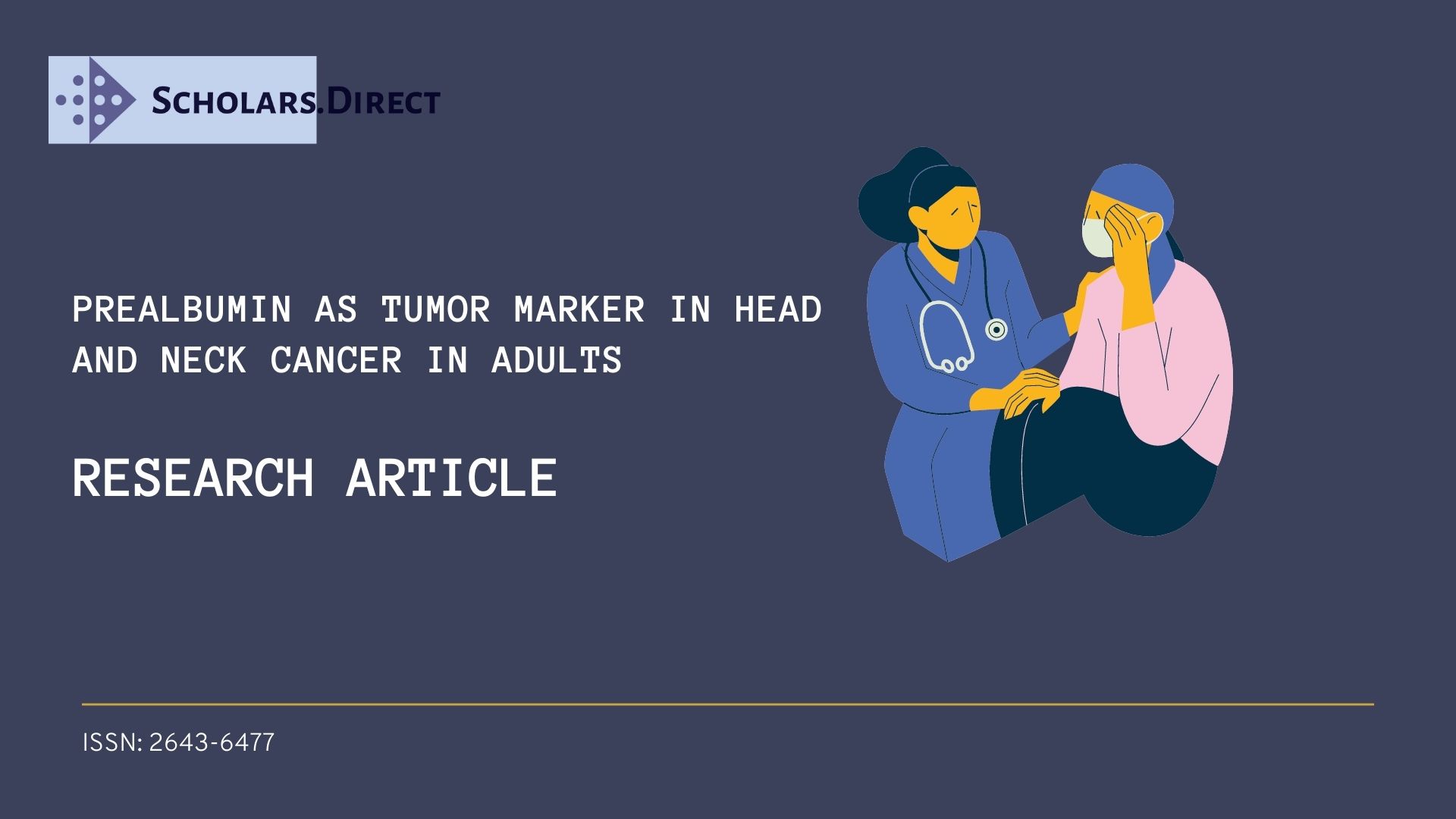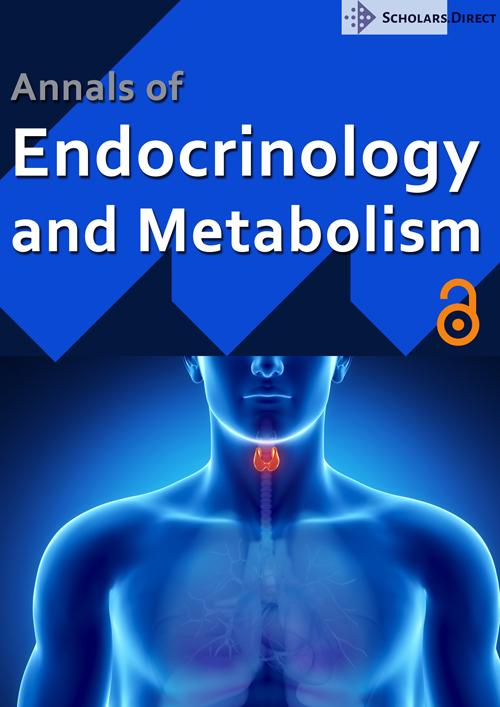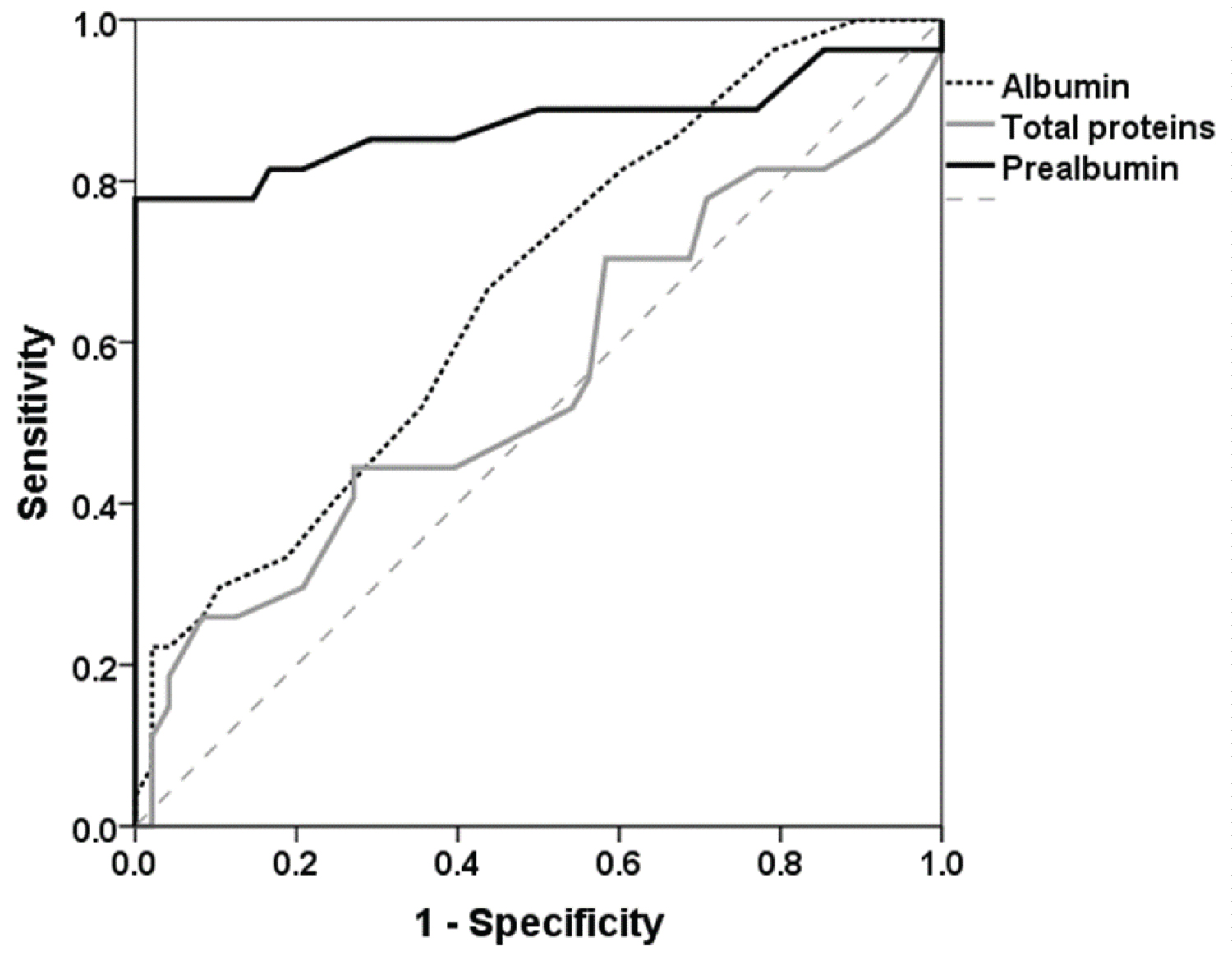Prealbumin as Tumor Marker in Head and Neck Cancer in Adults
Abstract
Introduction: Nowadays clinicians don't have a useful tumoral marker to perform the follow up of patients affected of head and neck cancers (H&NC).
Objectives: To analyse the operative characteristics of prealbumin (PRB) as a tumoral activity marker in those affected of head and neck cancer compared with albumin, total proteins, carcinoembryonic antigen, and alfa fetoprotein.
Methods: It was performed an observational prospective study with patients visited in Hospital Universitari Arnau de Vilanova de Lleida (Spain) with the main diagnosis of H&NC. During study time main epidemiological, clinical, and analytical (including PRB) characteristics were collected in 3 times: at diagnosis, after finishing the treatment and 12 months later.
Results: Blood samples were obtained from 138 patients from the 1st January 2007 till the 1st February 2010. Median age was 62.5 (29-89) years and 121 (88%) were males. Most frequent histological diagnosis was scamous carcinoma 87 cases (63%). 19 patients (14.5) died during that time. Sensitivity, specificity, positive and negative predictive values of PRB were 63%, 100%, 100%, 87% respectively. The area under receiver operating characteristic curve was 0.87 (CI 0.76-0.98), that was better than other parameters studied.
Conclusions: Prealbumin is a useful tumoral activity marker in those affected of head and neck cancer and it could be a useful tool in these patients follow up.
Keywords
Head and neck cancers, Tumor marker, Prealbumin
Abbreviations
H&NC: Head and Neck Cancers; CR: Complete Remission at 12 months; NCR: Non Complete Remission at 12 months; PRB: Prealbumin; PPV: Positive Predictive Value; NPV: Negative Predictive Value; AUROC: Area under Receiver Operating Characteristic Curve; CI: Confidence Interval; AJCC: American Joint Committee on Cancer; NCNN: National Comprehensive Cancer Network; CEA: Carcinoembryonic Antigen; AFP: Alfa Fetoprotein
Introduction
Head and neck tumors (H&NC) require a great effort for their diagnosis, treatment, and follow-up. Previous studies found a prevalence between 5 and 15 % of all neoplasms [1].
In a H&NC mortality study, done by cancer research foundation, H&NC was the sixth among men and the fourteen in woman [2]. The most common risk factors for developing H&NC are tobacco and alcohol use [3].
Nowadays clinicians don't have a useful tumor marker to perform the follow up of patients affected of H&NC.
The nutritional assessment of H&NC patients can help in the prognosis and follow-up of these patients. Prealbumin levels (PRB), better than albumin, have been used for nutritional evaluation [4-6].
The purpose of this study is to analyse the operative characteristics of PRB as a tumor activity marker in adults affected of H&NC compared to other tumor markers with common use in clinical practice.
Methods
It was performed an observational prospective study with patients visited in Hospital Universitari Arnau de Vilanova de Lleida with the main diagnosis of H&NC.
Inclusion criteria were age older than 18 years, histology of H&NC and to get informed consent. Lack of follow-up or consent were used as exclusion criteria.
Before starting oncological treatment (surgery, chemotherapy, radiological oncology, or a combination of them, following NCCN guidelines), it was performed a nutritional assessment a nutritional support and a follow up [7].
During study time main epidemiological, clinical, and analytical (including PRB) characteristics were collected in 3 times: at diagnosis, after finishing the treatment and 12 months later. The data that were analysed correspond to the second visit carried out a month after the initial treatment ended. In this visit, it was done a blood sample, determining level of total proteins, albumin, and prealbumin. We also checked tumoral markers such as carcinoembryonic antigen (CEA) and alfa fetoprotein (AFP) [8,9].
The CEA and FPA variables were categorical (positive or negative value). The cut-off points of positivity for CEA and AFP according to our laboratory were 5 and 10 ng/ml respectively.
The patients were classified according to whether they reached the state of complete remission (CR) or not (NCR) at the end of the treatment (at 12 months).
Statistical Analyses
With an estimated NCR percentage, according to a previous study, of 40-45% and for a precision of 95% (alpha error of 0.05) and a power of 90% (beta error of 0.1) a size between 135 and 225 patients was calculated. Results are shown as median (interquartile range), or percentage. Comparisons among groups were done by chi-square test, and by non-parametric test of Mann-Whitney for quantitative variables. All statistical analysis got a significance level lower than 0.05. Calculations of Sensitivity, specificity, positive and negative predictive values, and calculation of the area under receiver operating characteristic curve (AUROC) for comparing analysed tests by the statistical package R (version 2.9.0).
Results
Of the 140 patients chosen, 2 were excluded: one due to lack of follow-up and the other decided not to follow the treatment. Therefore, blood samples were obtained from 138 patients from January 1, 2007, to February 1, 2010. Median age was 62.5 (29-89) years and 121 (88%) were males. Table 1 shows the results of the study group and divided according to whether they achieve CR (55.8%) or do not achieve it (44.2%).
Most frequent histological diagnosis was squamous carcinoma 87 cases (63%), and the most frequent location was larynx. More than half of the patients were diagnosed in stage IV. Mortality during the follow-up period was 19 patients (14.5%).
Table 2 shows the analytical values studied. Significant differences are observed in albumin and prealbumin values. And Table 3 shows the accuracy values achieved by the different analytical parameters. Figure 1 shows the differences in the AUROC of albumin, prealbumin and total protein values.
Discussion
There are no previous studies about PRB as a tumoral marker for H&NC in adults. Our sample of patients with HN agrees with others in the values of remission and mortality [9]. We also agree in other studies in the proportion of men and in the age, values found [10]. Regarding the location, we obtain similar results to the series published by the Cancer Research Foundation in Spain with most patients diagnosed at advanced stage (III or IV) [11].
The most common histology in our population was in 63% of cases de scamous carcinoma, followed by epidermoid carcinoma in 21% patients and, less frequent carcinoma "in situ", small cell carcinoma, undifferentiated and adenoid-cystic carcinoma. What is different from previous studies, where the most frequent is epidermoid carcinoma [12,13].
Limitations of our work include the limited sample size and the need to validate our results in an external population.
In summary, we considered PRB as a tumor marker in the follow-up of adult patients with H&NC.
Conclusions
1. PRB is a useful tumoral marker in adults with H&NC.
2. Albumin and total proteins are not useful tumoral marker in adults with H&NC.
Declarations
Ethics approval and consent to participate
All the procedures used in the present study were in conformity with the current revision of the Helsinki Declaration. All participants were informed of the objectives of the study, and they were enrolled only after providing a signed consent form.
Consent for publication
All the authors approved the final version of the manuscript and consented for its publication.
Availability of data and materials
Data will be made available by the corresponding author upon request.
Competing interests
All the authors declared no competing interest.
Funding
None.
Authors' contributions
Study conception: CM, RA, TJ; Data collection: CM, GC, BM, SM, BP, SE. Data analysis and Manuscript drafting: CM, RA, TJ, CM. All authors read and approved the final manuscript.
Acknowledgements
To all the patients who participated to this study.
References
- Davis WE, Zitsch RP (1999) Statistics of head and neck cancer. In: Thawley SE, Panje WR, Batsakis JG, et al. WB Saunders Company Comprehensive management of head and neck tumors. (2nd edn), Philadelphia, 283-295.
- Cohen N, Fedewa S, Chen AY (2018) Epidemiology and demographics of the head and neck cancer population. Oral Maxillofac Surg Clin North Am 30: 381-395.
- Richardson SJ (2009) Evolutionary changes to transthyretin: Evolution of transthyretin biosynthesis. FEBS J 276: 5342-5356.
- Suyama Y, Adachi K, Notsu Y, et al. (2009) Efficacy of corrected rapid turnover protein increment index (CRII) for early detection of improvement of nutrition status in patients with malnutrition. J Clin Biochem Nutr 45: 44-48.
- Geisler JP, Linnemeier GC, Thomas AJ, et al. (2007) Nutritional assessment using prealbumin as an objective criterion to determine whom should not undergo primary radical cytoreductive surgery for ovarian cancer. Gynecol Oncol 106: 128-131.
- Liu L, Wang J, Liu B, et al. (2008) Serum levels of variants of transthyretin down-regulation in cholangiocarcinoma. J Cell Biochem 104: 745-755.
- Dhankhar R, Dahiya K, Sharma TK, et al. (2011) Diagnostic significance of adenosine deaminase, uric acid and C-reactive protein levels in patients of head and neck carcinoma. Clin Lab 57: 795-798.
- Biazevic MG, Antunes JL, Togni J, et al. (2010) Survival and quality of life of patients with oral and oropharyngeal cancer at 1-year follow-up of tumor resection. J Appl Oral Sci 18: 279-284.
- Duffaud F, Therasse P (2000) New guidelines to evaluate the response to treatment in solid tumors. Bull Cancer 87: 881-886.
- Aksoy M, Baykul T, Yilmaz HH, et al. (2010) Early diagnosis of oral cancer. J Int Med Res 38: 737-749.
- Granell J, Puig A (2004) Registro de cáncer de cabeza y cuello: Estudio prospectivo de incidencia a dos años. Oncología (Barc.) 27: 33-39.
- Friedrich RE (2010) Delay in diagnosis and referral patterns of 646 patients with oral and maxillofacial cancer: A report from a single institution in Hamburg, Germany. Anticancer Res 30: 1833-1836.
- Bedikian AY, Wei C, Detry M, et al. (2010) Predictive factors for the development of brain metastasis in advanced unresectable metastatic melanoma. Am J Clin Oncol 34: 603-610.
Corresponding Author
Mariaina Cerdá Esteve, Endocrinology and Nutrition, Head and Neck Cancer Committee, Hospital Universitari Arnau de Vilanova de Lleida, Avda, Rovira Roure 80, 25006 Lleida, Spain.
Copyright
© 2021 Cerda EM, et al. This is an open-access article distributed under the terms of the Creative Commons Attribution License, which permits unrestricted use, distribution, and reproduction in any medium, provided the original author and source are credited.






